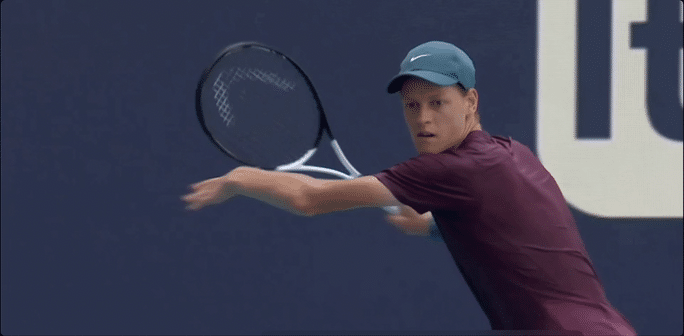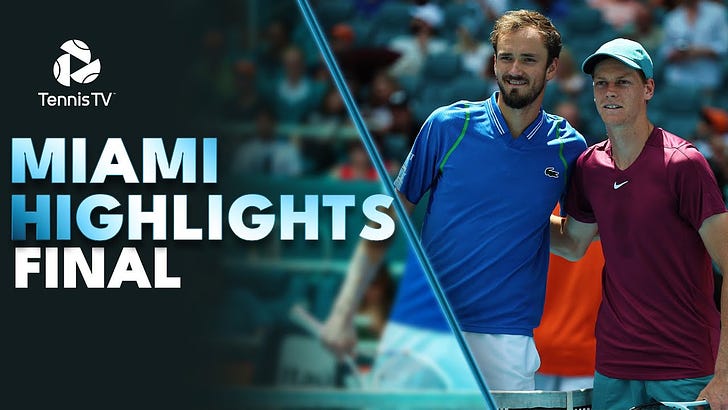Medvedev x Sinner: Miami Final Analysis
moving forward—merry-go-rounds and Ferris wheels—incentives
Daniil Medvedev defeated Jannik Sinner 7/5 6/3 in the final of the Miami Masters on Sunday to claim his fifth Masters 1000 title. The Russian has now made five finals in a row, winning four titles (lost to Alcaraz in the Indian Wells final). Sinner is now 0-6 versus Medvedev.
The opening rallies of this encounter showcased why Sinner struggles against the baseline sponge that Medvedev embodies. The Russian loves to absorb. The harder the better. Sinner’s game—as it currently stands—is all about aggression; he loves to attack. A look at their return positions:


Sinner has made numerous tweaks to his serve over the past 18 months and it has improved, but it lacks the precision, power, or percentage of better servers in its current iteration, and coupled with their vastly different return positions, the tradeoffs completely favoured Medvedev. Over 40% of Medvedev’s serve went unreturned compared to Sinner’s 25%.

Neither player has great intangibles (yet1) such as short slices, net sneaks, or drop shots to effectively break this standoff. The second rally of the match was 19 shots. It also hinted at the tactics of both: Medvedev served to the Sinner forehand ~60% of the time off both the Deuce and Ad court in this match (and to be fair I think these are his favorite serve spots irrespective of who he plays). But off the ground the Russian was somewhat agnostic to picking sides, tending to play his trademark deep middle rally ball and let Sinner take on the risk. In contrast, Sinner tried to make it a match of forehands. A breakdown of their forehand shot placements (left = Sinner).


The backhands paint a similar picture with Sinner taking his backhand down the line more often in a bid to find forehands (left = sinner):


For Medvedev, this was a total constriction job as he starved Sinner of height or variation. The Russian also averaged a higher ball speed off both wings courtesy of how flat he hits, and he certainly benefitted more from the faster Miami conditions (compared to, say, Indian Wells).
To Sinner’s credit, he did look to come forward and had success when sneaking in on the Medvedev backhand on several occasions. This is an obvious play against the Russian, but he will make you pay if the execution is poor:


The below pass is phenomenal and highlights the risk of volleying deep if you don’t get it right.
The commentators also noted that in Sinner’s first four matches, he ventured forward only 19 times, yet came forward 25 times against Alcaraz alone in the semifinals. He needed to do it more against Medvedev.
It’s fair to acknowledge that Sinner was clearly jaded from his semifinal against Alcaraz, especially in the second set. But his problems against Medvedev are tactical in nature, rather than just physical. In Gill Gross’ analysis, he said of Sinner:
“He [Sinner] doesn’t have the gift of timing to the extent he has the gift of power…”
While I agree with this overall message, I wouldn’t call it a gift as much as it is a consequence of technique. Once again I would argue the exaggerated outside set-up on Sinner’s forehand just makes it harder to time, and this will always leave him more exposed to mistiming the ball compared to a swing that has less flip on the outside, especially given how hard and early he tries to take that shot.

In Death of a Forehand I asked the question if these “noisier” outside setups with more lag/flip on the outside—while perhaps saving time and accelerating the racquet within a smaller range to produce wicked racquet head speed—might lack the consistency of the fuller takebacks we had seen in the GOAT-ing forehands of Sampras, del Potro, Nadal, 2000s Federer, and Gonzalez.

Compare the above gif of Sinner with some GOAT-ing forehands below. To make an analogy: the game has trended toward “more merry-go-round, less Ferris-Wheel” when it comes to forehand and backhand setups.
Perhaps grip is a qualifier—eastern grips may adjust to such setups more easily as we see in Tsitsipas and post-2012 Federer—but my hunch is that this setup will be more prone to mistiming the ball, god-given gifts of timing or not. And unsurprisingly the best forehand to emerge since the Big-3 belongs to Carlos Alcaraz, and his is more Ferris Wheel in its takeback (add peak Thiem to that list also).
In Death of a Forehand I also noted that the weight and swingweight of player frames had trended down in concert with these swings, likely resulting in a racquet head that moves through more degrees in a shorter amount of time. I went down a rabbit hole on racquet properties over the weekend and stumbled upon an article from Duane Knudson (emphasis added)2:
“In theory, a lower mass racket is easier to move and accuracy might improve given the more sub-maximal efforts that are used. However, a tennis player is likely to swing the lower mass racket faster; that, in general, means lower accuracy because of the well-known speed-accuracy tradeoff…A racket with greater higher mass and swingweight might help a player with long, erratic strokes and a tendency to over-hit strokes in rallies.”
If players are going to persist with these shorter/more outside setups then they must be used in service of taking the ball early and coming forward/moving up the court, which is what Alcaraz does and what an older post-2012 Federer looked like also. Staying back and trying to out-rally players with fuller takebacks turns the feature into a bug. I don’t think long-term you can win the baseline battle against the best exponents of the counterpuncher (Medvedev and Djokovic). Perhaps this reflects Sinner’s relatively poor record against top-5 opposition. Perhaps it also reflects a general incentive toward risk-averse baseline tennis as an optimal strategy, but that’s a topic for another post.
As we move into the clay swing it will be interesting to see how Alcaraz and Sinner perform (as well as Medvedev now that he’s built up all this momentum). I’m hoping that a host of top-10 players find form as we approach the French Open:
The return of Djokovic and a hopefully healthy Nadal.
Rune needs to find his mojo again and I think dropping PM was a good move.
Can FAA find some form on the clay? Taking a break with knee pain.
Tsitsipas has points to defend in Monte Carlo after a poor and injury-riddled Sunshine Double. A great AO campaign, but the backhand is still a liability.
Former US Open champion Dominic Thiem has just won back-to-back matches after months of tough losses. Can he find his peak again in 2023?
See you soon for some dirt analysis later in April.
Sinner is clearly working on using the forehand drop shot and while he didn’t execute well in this match (and hasn’t achieved the same feel that Alcaraz gets off his forehand, or Djoker gets off his backhand) it is admirable and positive to see him incorporating this. In time he will get it right.
Knudson, D. (2008). Biomechanical aspects of the tennis racket. In Hong, Y., & Bartlett, R. Routledge Handbook of Biomechanics and Human Movement Science.





Great stuff Hugh. Yes, the dynamic lag/flip on the Sinner forehand quite the contrast to the old school Medvedev forehand. Sinners forehand is certainly close to the Jack Sock forehand, which is perhaps the ultimate example of that type of technique. I personally like it, but there are the smallest of margins that determine the outcome of these matches. Who know what is best? Medvedev has had a great hard court run. To me, the party is over for him. The clay season is the bare knuckles portion of the season. Med, with his deficit spin game, is simply not in the conversation to me.